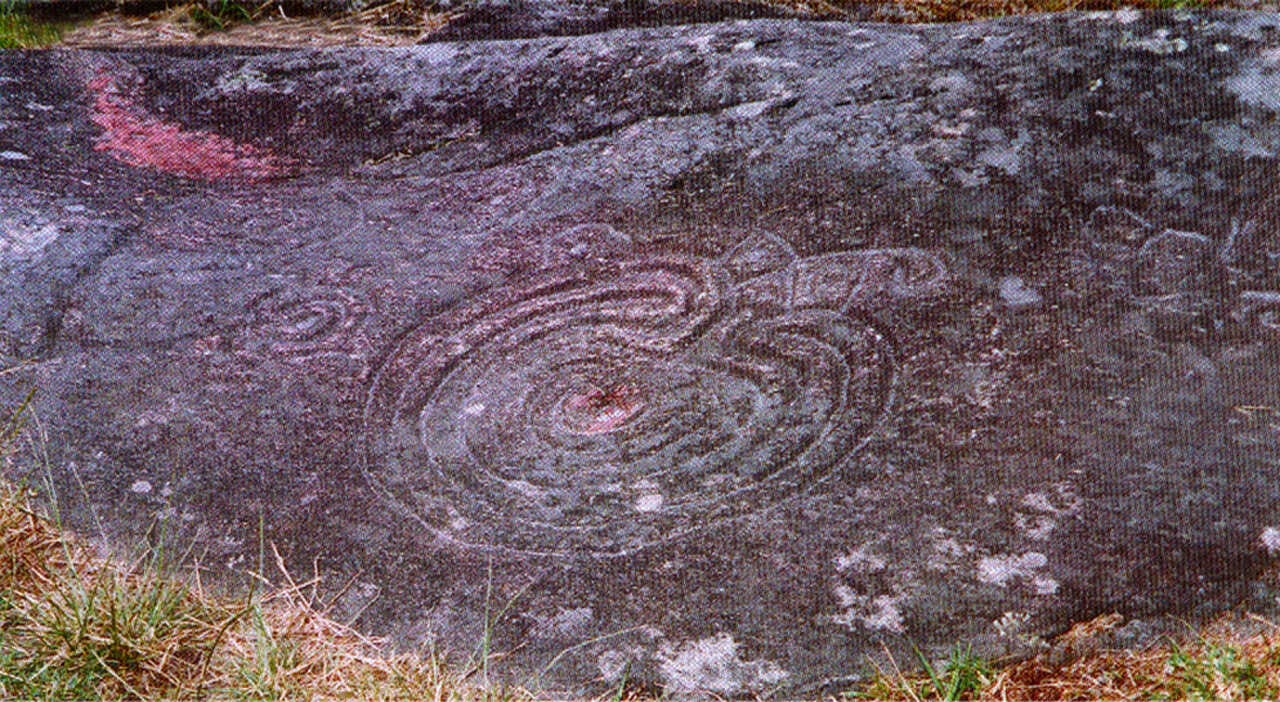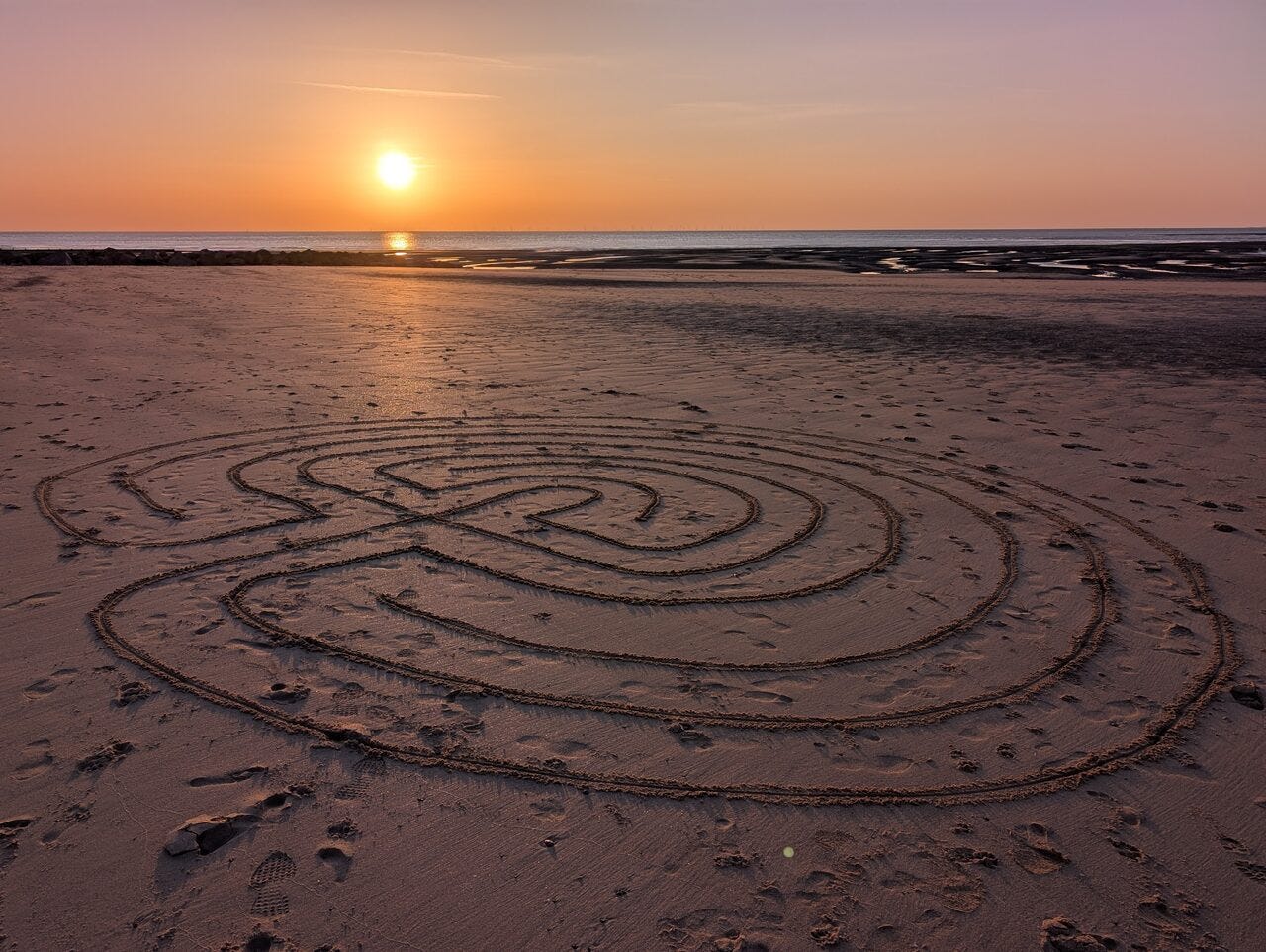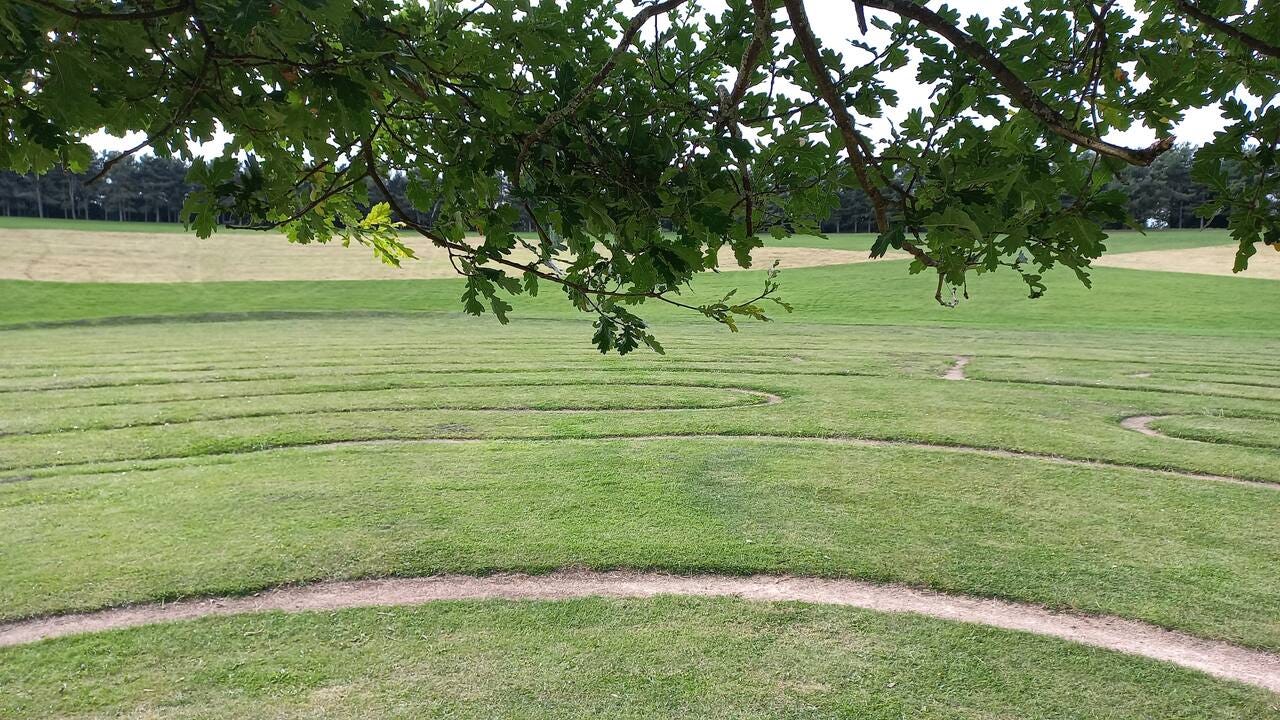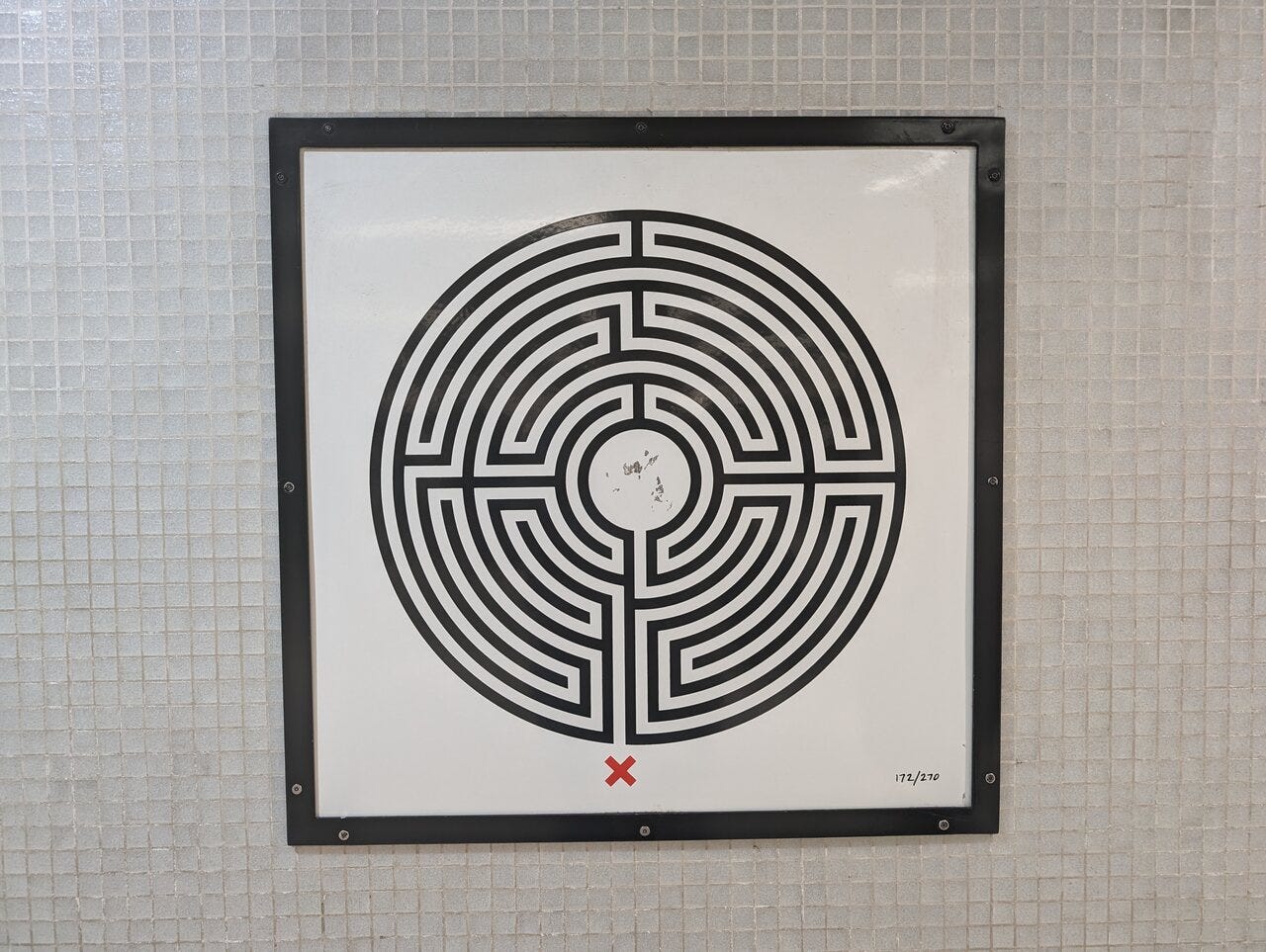Around 4,000 years ago, an unknown artist carved a mysterious and previous unseen symbol on a rock in Galicia. Cup and ring marks, etched into stones with their distinctive central depression and surrounding concentric circles, were already widespread across Atlantic Europe. But this was a new variation: the labyrinth.

This first labyrinth was recorded as a petroglyph, but it has an immeasurably long history as a walkable space. A labyrinth consists of a single path that winds inward and outward through concentric circles from its entrance to the centre, unbroken and unbranching. The classical labyrinth is often attributed to the Minoan civilisation of ancient Crete, featuring at the heart of the story of the minotaur. But in truth, the basic design is astonishingly common in cultures across the world.
Today is World Labyrinth Day, a global celebration of the labyrinth’s enduring symbolism and transformative power. Many people around the globe will “walk as one at one”, creating a peaceful wave of energy around the world. If you’ve never walked a labyrinth before, today might be the day.
From the land of wanderers…

Galicia is a land of wanderers, so perhaps it’s a fitting that the earliest labyrinth was carved into a rock on its coastline. Situated in the northwesternmost part of the Iberian peninsula, the region is shaped by a thousand rivers that descend from high granite mountains to deep rías, steep-sided ice age valleys that flooded into estuaries as sea levels rose.
The neolithic dolmens and rock carvings scattered across the landscape were already ancient when Bronze Age sailors began trading metals and sharing their culture along the Atlantic seaboard, reaching as far north as Ireland and Scotland. These ancient wanderers became known as the Gallaeci, the Celtic tribe that lends its name to the land they sailed from.
The Gallaeci left an indelible mark on Galicia. Although the Gallaecian language was trampled under the boots of an advancing Roman army, traces of it remain, buried in inscriptions, place names and the etymology of a handful of words, including the Galician for path: camiño.
First-hand written accounts of wandering begin with a solitary departure from Galicia. In 381CE, Egeria left her home in the region to embark on a journey that took her to sites in the Holy Land, Egypt, Mesopotamia and Asia Minor. She climbed mountains, forded rivers, observed rituals, and documented her wandering life. This intrepid woman’s account of her three-year journey is the earliest record of christian pilgrimage, inspiring seekers to step onto the path to enlightenment.
Galicia is best known today as a pilgrimage destination. The world-renowned Camino de Santiago draws hundreds of thousands of pilgrims each year to the cathedral in the region’s capital. But underneath Galicia’s heritage of modern-day pilgrimage, there is a deeper tradition of nature-centred devotion, connection to the land and engagement with the mysteries of the universe. And its story of wandering began in the labyrinth.
…towards a global path
We’ll never know for certain why ancient walkers were drawn to explore the labyrinth. In the later medieval tradition, the labyrinth became a symbol of pilgrimage, encapsulating a pattern of the soul’s journey towards meaning and transcendence. Perhaps the singular, winding path of the labyrinth held similar symbolic meaning for our prehistoric ancestors, too.
But stepping into the labyrinth - whether classical or medieval design - remains an opportunity to meet mystery on the path. For the countless individuals who have walked the labyrinth through history, the path has offered itself with gentle simplicity. In return for the quiet stepping of one foot in front of the other, profound questions are answered, peace is found, and inspiration is gained. Sometimes a walk is just a walk. But often in the labyrinth, it is so much more.
Unlike a maze, which presents countless junctions and blind alleys, the labyrinth is a place to disengage the conscious mind and be present to the simple act of walking. There are no choices to be made in a labyrinth. The path is determined for us, and we need only follow the path to the centre, then pause and return.
Thanks to the energy of their modern revival, public labyrinths are increasingly accessible. The Worldwide Labyrinth Locator is an indispensable guide to finding one near you. In churchyards, country parks and urban spaces around the globe, they are often laid in patterns of paving stones, making the path navigable with walkers and wheelchairs. Temporary labyrinths are constructed on beaches, marked out on grass and chalked onto tarmac.
As labyrinths become more abundant, more of us have the chance to meet ourselves on the path. Singular acts of wandering have become a global movement.
Labyrinth walking as ritual
I first walked the labyrinth almost twenty years ago in the shadow of San Francisco’s Grace Cathedral. Since then, I’ve met labyrinths created by others in woodland glades, city courtyards, cathedral floors and wide-open meadows. And I regularly draw the shape of the classical labyrinth on the beach, carving out a path to walk by dragging a stick through the soft, damp sand of low tide.
Many people find the act of walking the labyrinth expresses the rhythm of ritual. Walking towards the centre echoes the journey of departure, stepping from the concerns of the ordinary world into a magical place where anything might happen. Eventually, the path winds to the centre, a site of stillness and insight where mystery can meet us with transformative power. And the path must then be walked in reverse, allowing us to integrate our experience as we reach the gateway back into ordinary reality.
The labyrinth offers itself as a potent liminal space, outside of ordinary time. So, sometimes, I approach a labyrinth with a specific problem to resolve. Other times, I carry the ache of suffering. But most often, the act of stepping through the entrance to a labyrinth is just an act of surrender to mystery.
For a few minutes, I can give myself wholly to the path, letting my breath and my body carry me in silence. I can pause in the centre and give thanks. And I can return with calm in my heart, quiet in my mind and peace at my feet.
Labyrinth lessons
The peace I find on the labyrinth’s path creates the possibility of reconciling my inner journey and my outer wandering. Dropping into the feeling of connection with the earth beneath my feet, I can become more conscious of being intertwined with the ecosystems that support and nurture my life. Especially when walking an outdoor labyrinth, every turn offers me a new view of the more-than-human community that surrounds and enfolds me.
Despite its lack of choices, if I engage my mind, the journey through the labyrinth can be confusing. Within a handful of turns, I might find myself within touching distance of the centre, but the path determines to take me out to the outer edges of the field. And then, as I am losing hope of ever reaching its end, I find myself snaking back towards the middle.
Though I’ve walked and drawn the labyrinth a thousand times, my mind cannot hold its shape as a series of instructions to turn. I must always trust my feet to find the way.
What have I learned from the countless labyrinths I've walked? Here are seven simple lessons.
The path I walk can take me so close to my goal, and then so far away, almost in an instant. What matters is my intention to keep walking.
All I can do in life is continue to put one foot in front of the other, and move forward.
When I feel I have lost my way, I should ask myself whether I have truly lost my path or whether my journey has simply taken an unexpected turn. These are fundamentally different. If I have lost my path, I need to stop and double back. If my path has taken an unexpected turn, I need to keep moving forward, and trust that all will become clear.
Others may follow my path, cut across, shortcut, leave the trail, join, depart, complain, rejoice, question and wonder. I must simply keep walking.
Any path worth following demands my time, energy and effort. Yes, I could take the shortcuts. After all, the only thing that keeps me on my path is my determination to follow it. But I believe there is learning in every step of the journey.
Like many people, I feel two urges in me: a calling to wander and a calling to take root. At the end of my journey in the labyrinth, I rarely want it to end. I must notice and honour this contradiction in myself, and find a way to dwell in the space of possibility and potential it creates in me.
Sometimes a walk is just a walk. But there is more to learn, always.
Take your next step

Few of us are able to step away from our lives for a period of extended pilgrimage or wandering, but the labyrinth offers an accessible microcosm to experience the journey of a lifetime. It can be a simple and profound path to personal transformation, peace and self-acceptance.
Walking the labyrinth, with its single, determined path, is a gift that allows us to quiet our busy minds, move with intention and step beyond the ordinary into a place of mystery and wonder. It is a space to meet ourselves on the path and integrate whatever we encounter into our everyday lives.
This weekend, find a labyrinth. See what you discover in your next step.








I appreciate the opportunity to listen to your post Dru, it enabled me to paint a labyrinth as I was listening to it. There was such a calm in the paint line going in to the centre and out again. Thank you!
Thank you for the World Labyrinths link. I look forward to exploring more of these on my travels!
Loved reading your lessons. Beautiful reflections.